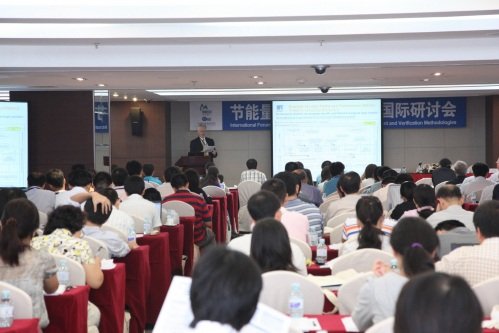 As we begin a new round of international climate negotiations in Cancun, China has taken another potentially giant step towards meeting its climate pledge. On November 4, 2010, China's central government enacted national energy efficiency regulations that will establish national utility demand-side management, or DSM programs. (See here for the official DSM government announcement in Chinese, here for the regulations in Chinese, and here for our unofficial English translation). These game-changing regulations will, for the first time, require China's power grid companies to use a portion of their electricity revenues to develop large-scale programs for helping China's factories, businesses and homes invest in energy efficiency. The regulations will require grid companies to achieve specific energy savings targets, similar to Energy Efficiency Resource Standards passed in 19 states in the U.S. These regulations have the potential to help China dramatically scale up its efficiency programs to substantially reduce energy consumption and emissions growth. For more than a decade NRDC has been pushing for such a national policy to require that electricity companies invest in energy efficiency programs for their customers. We are delighted that these efforts have finally paid off.
As we begin a new round of international climate negotiations in Cancun, China has taken another potentially giant step towards meeting its climate pledge. On November 4, 2010, China's central government enacted national energy efficiency regulations that will establish national utility demand-side management, or DSM programs. (See here for the official DSM government announcement in Chinese, here for the regulations in Chinese, and here for our unofficial English translation). These game-changing regulations will, for the first time, require China's power grid companies to use a portion of their electricity revenues to develop large-scale programs for helping China's factories, businesses and homes invest in energy efficiency. The regulations will require grid companies to achieve specific energy savings targets, similar to Energy Efficiency Resource Standards passed in 19 states in the U.S. These regulations have the potential to help China dramatically scale up its efficiency programs to substantially reduce energy consumption and emissions growth. For more than a decade NRDC has been pushing for such a national policy to require that electricity companies invest in energy efficiency programs for their customers. We are delighted that these efforts have finally paid off.
The new DSM regulations ("DSM Implementation Measures"), which will come into effect on January 1, 2011, were jointly issued under the auspices of the State Council by six commissions and ministries, led by China's most powerful government agency, the National Development and Reform Commission. The regulations are significant in a number of ways:
• Integrated Resource Planning: First and foremost, the regulations call for integrated resource planning that considers both supply side and demand side options. The regulations further specify that demand side measures should be considered and given priority in meeting demand growth. The regulations require local authorities to incorporate these energy efficiency savings into their power industry development plans, energy development plans and local economic development plans. These provisions are key since they mean that China's grid companies and local governments must give priority to meeting the country's explosive growth in power demand through energy efficiency rather than more coal-fired power plants.
This is a positive development for China's economy as well as the environment not only because saving electricity through efficiency is much cheaper than generating additional power but also because it avoids pollution and carbon emissions from power plants. The International Energy Agency estimates that, on average, each additional $1 spent on more efficient electrical equipment, appliances and buildings avoids more than $2 in investment in electrical supply.
• Energy Efficiency Resource Standard: In addition, the regulations place responsibility for DSM implementation squarely on the shoulders of power grid companies by requiring these companies to achieve energy savings through DSM equivalent to at least 0.3% in sales volume and 0.3% in maximum load compared with their previous year.
Once fully implemented, this target, also known as an energy efficiency resource standard (EERS) will achieve considerable energy savings. China's total electricity consumption in 2009 was 3.643 trillion kWh, so a 0.3% reduction would roughly translate to 11 billion kWh – enough electricity to supply 1 million average U.S. households (or 10 million Chinese homes[1]) for a year.
• Funding Mechanism for Energy Efficiency Investments: Furthermore, the regulations authorize three sources of DSM funding: public utility surcharges beyond the electricity rate, revenue from differentiated electricity prices, and/or other government budget allocations. In addition, legitimate expenses in DSM implementation by power grid companies may be incorporated into power supply cost. These regulations will therefore help establish a national long-term sustainable funding mechanism for energy efficiency investments in China – an essential step in unlocking China's vast energy efficiency potential. A World Bank study concluded that with the proper policies and incentives, DSM programs could reduce China's electricity needs by 220 terawatt hours[2] and avoid the need to build more than 100 GW of new electric capacity by 2020.
• Monitoring and Verification of Energy Savings: Finally, the regulations encourage – though do not go so far as to require – verification of energy savings through independent third parties. Nevertheless, during offline conversations with various entities, it seems that many government officials are supportive of developing an independent third party verification system. Such a system, which is already being developed in China, could support a national system for monitoring, reporting and verification (MRV) of China's greenhouse gas emission reductions (as I've blogged about here).
Although China has enacted many energy efficiency policies and measures, these new DSM regulations can help take the country's ambitious energy saving programs to an entirely new level. Even though China announced last week that it will reach its 20 percent energy intensity reduction target for 2005-2010, in large part by closing many inefficient and highly polluting plants, some of the savings were from temporary measures that will have little long-term impact. The DSM regulations will help China develop policies and structures that incentivize enterprises to ramp up significantly their investments in energy efficiency, and will collectively bundle these improvements in end-use energy efficiency into virtual "efficiency power plants (EPPs)" that avoid the need to build conventional power plants. These are long-term, sustainable measures for reducing energy consumption and emissions.
Jiangsu's Leadership in Demonstrating the Benefits of DSM: NRDC, along with our long-term partners, the Energy Foundation and the Regulatory Assistance Project, helped bring DSM policies to China through advocacy and technical cooperation in Jiangsu Province that first started a decade ago. In 2004, we worked with China's national government and Jiangsu Province to help launch China's first large-scale DSM pilot program in Jiangsu. In 2005, NRDC and the China-U.S. Energy Efficiency Alliance helped broker and implement an agreement on DSM cooperation between the California Public Utilities Commission, the California Energy Commission, and the Jiangsu Economic and Trade Commission. These initial efforts laid the foundation for demonstrating in China the value of establishing large-scale DSM programs to meet environmental and energy goals.
In the first three years of our cooperation, Jiangsu estimates that its DSM investments avoided the need to build 300 MW in new power generation capacity and 580 MW of peak load. Since then, Jiangsu has avoided another 300 MW of new power—600 MW in total—and is now saving 2 terawatt hours of electricity annually. These programs are reducing CO2 emissions by 2.24 million tons a year. By the end of 2010, they will have eliminated more than 13 million tons of cumulative CO2 emissions from the atmosphere. All of this has been achieved at a cost of less than $15 million a year to the Jiangsu government—an investment that has more than paid for itself since investing in efficiency measures costs one-third the cost of building a conventional power plant.
(Update: Jiangsu has just published the new statistics on its DSM program that demonstrate even greater energy and carbon savings at a lower cost. Here is a revised paragraph with the new statistics: "In the first three years of our cooperation, Jiangsu estimates that its DSM investments avoided the need to build 300 MW in new power generation capacity and 580 MW of peak load. Since then, Jiangsu has avoided more than 300 MW of new power—680 MW in total—and is now saving 3.5 terawatt hours of electricity annually. These programs are reducing CO2 emissions by about 3.4 million tons a year. All of this has been achieved at a cost of 240 million RMB over the four year period from 2006-2009 (or $9 million a year on average) to the Jiangsu government—an investment that has more than paid for itself since investing in efficiency measures costs one-third the cost of building a conventional power plant".
Chinese Premier Wen Jiabao has hailed Jiangsu as a national model, and China’s new national DSM regulations are proof that this subnational initiative has had a major influence on the country's energy policies.
U.S. States Also Leading on DSM: Jiangsu's success in building a DSM program drew on the expertise and experiences of California's regulators, utilities and businesses in a highly successful capacity-building effort that shows the benefits of U.S.-China cooperation on climate and clean energy. In fact, the California-Jiangsu partnership has been so successful that in 2009, California and Jiangsu signed a new agreement to cooperate on climate change (also see my posting here) – China's first-ever subnational agreement to reduce greenhouse gas emissions. NRDC is helping implement this agreement by working with Jiangsu to save energy and reduce greenhouse gas emissions through new DSM efforts in the building sector (see my recent post about the importance of building energy efficiency in China).
In California, DSM energy efficiency programs have provided nearly $5 billion in net benefits to customers statewide over the last decade alone (see more details here). New programs planned over the next three years are expected to provide even greater savings to California consumers while creating more than 15,000 skilled green jobs. In 2008 alone, the pollution savings from efficiency programs (which have accumulated since the state first began programs in earnest in the mid-1970s) totaled nearly 1,000 tons of smog-forming nitrogen oxides and provided global warming pollution savings equivalent to the emissions from 3 million cars. Other states are also pursuing DSM programs to meet their energy goals (e.g., just two weeks ago, in Illinois, Commonwealth Edison, NRDC, and other parties and regulators signed a DSM agreement that will result in massive savings for ratepayers and potentially eliminate the need for new dirty coal plants in the region).
Countries Must Continue to Move Forward on Climate Change: The current average target of those U.S. states that have adopted EERS is higher than China's 0.3% target, and some state EERS are much higher. Yet China has leapfrogged the U.S. by adopting a national EERS, applicable to every grid company in the country. The U.S. still lacks a national EERS, though an EERS provision was included in the comprehensive climate and energy legislation passed by the U.S. House of Representatives last year.
As my colleague Jake Schmidt pointed out in a recent blog, countries are not waiting around for an international climate agreement before taking action at home. China certainly isn't. The implementation of the national DSM regulations could significantly increase China's ability to tap its enormous potential for energy efficiency, which in turn would go a long way toward meeting China's target of reducing its carbon intensity by 40-45% by 2020 from 2005 levels.
(This post was co-authored with NRDC China Energy Efficiency/DSM Project Director Mona Yew and NRDC legal fellow Bruce Ho.)
[1] Based on average household consumption of 87 kWh per month.
[2] A terawatt is equivalent to 1 trillion watts.


